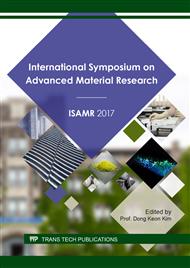[1]
F. Ma, Q. Wang, X. S. Zhu, Application status and development trend of magnetic technology in wastewater treatment, J. China Water Wastewater, 14 (2010) 34-37.
Google Scholar
[2]
T. Agnieszka, W. Lidia, Enhancement of biological wastewater treatment by magnetic field exposure, J. Desalination. 222(1-3) (2008) 368-373.
DOI: 10.1016/j.desal.2007.01.144
Google Scholar
[3]
L. Sitong, Y. Fenglin, M. Fangang, Enhanced anammox consortium activity for nitrogen removal: Impacts of static magnetic field, J. Biotechnol. 138(3-4) (2008) 96-102.
DOI: 10.1016/j.jbiotec.2008.08.002
Google Scholar
[4]
G. L. Zhu, Y. Y. Hu, Nitrogen removal with ANAMMOX mixed culture immobilized in different materials, J. Acta Scientiae Circumstantiae. 9 (2008) 1861-1866.
Google Scholar
[5]
S. Johan, S. S. Hon, Lavania-B, Removal of scale deposition on pipe walls by using magnetic field treatment and the effects of magnetic strength, J. Clean. Prod. 139 (2016) 1393-1399.
DOI: 10.1016/j.jclepro.2016.09.028
Google Scholar
[6]
S. Liu, F. Yang, F. Meng, Enhanced anammox consortium activity for nitrogen removal: Impacts of static magnetic field, J. Biotech. 138(3-4) (2008) 96-102.
DOI: 10.1016/j.jbiotec.2008.08.002
Google Scholar
[7]
R. K. Sidhu, Influence of particle size of iron powder on the microstructure of NdFeB alloy powder prepared by reduction diffusion, J. Magn. Magn. Mater. 346 (2002) 250-254.
DOI: 10.1016/s0925-8388(02)00496-6
Google Scholar
[8]
W. J. Shen, B. Q. Wang, N. J. Gu, Study on the influence factors of the properties of NeFeB bonded magnet, J. Hebei Univ. Technol. 4 (2003) 82-86.
Google Scholar
[9]
M. B. Tian, Magnetic Material, Bei Jing, (2000).
Google Scholar
[10]
H. Liu, B. H. Tian, S. F. Wang, nano Fe3O4 magnetic particles preparation and adsorption study, J. Environ. Eng. 4 (2010) 781-784.
Google Scholar
[11]
Preparation of functional nano Fe3O4 magnetic material and its removal of heavy metal ions in water, J. Progress Chem. 25 (2013) 2147-2157.
Google Scholar
[12]
J. Chen, X. Wang, B. Zhao, Embedding fixation of A. faecalis strain NR and ammonia nitrogen degradation properties, J. Enviro. Eng. 6 (2016) 3303-3311.
Google Scholar


